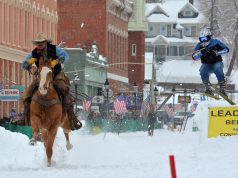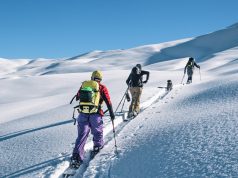
Denison von Maur adds another log to the wood stove, looks up and smiles. He’s in his element, high up in the Beaverhead mountains, the wind blasting across the ridge as a snow squall spits flakes across the windows of the remote log cabin he built by hand. The fire now blazing, he sits down, cracks a cold beer and starts talking about Altoona Ridge Lodge.
The lodge is actually one of three small cabins on a mining claim Maur built with his wife, using local materials, during summer from 2007 to 2010. They’re clustered in a group, and complemented by a yurt and a wood-powered sauna. Just over three hours from Bozeman, the cabins are part of a growing collection of options that backcountry skiers have in Montana. From yurts to tents to the luxury of Altoona, it’s a trend that has been inspired by the rich array of options in other states, particularly Colorado, with its famed 10th Mountain Hut system.
In fact, Maur spent several years living and skiing in Vail, and the lessons he learned when taking advantage of the 10th’s system of backcountry accommodations as a customer have been applied to the layout of Altoona Ridge.
First, there’s the multiple structure layout of Altoona. Maur had the “joy,” as he describes it, of spending a night in a Colorado hut with a fraternity and some kegs. That’s a fine set of circumstances if you’ve headed into the backcountry with the idea of partying all night. But as a passionate and accomplished skier, Maur’s priorities tend toward early morning powder runs versus all-night revelry. By design, Altoona has one main cabin for cooking, hanging out and, of course, late-night storytelling. The other cabins and the yurt are for sleeping. Want to get rowdy all night long? Sure, go for it. The rest of your party can opt out and hit the hay early. They won’t be kept awake by your tomfoolery.
Other lessons learned? Ditch long ski-in approaches with heavy packs in favor of snowmobile access. While “snowmobile” may be a dirty word among some aficionados of human-powered backcountry adventure, at Altoona, the shuttle service allows for painless access with a lot of provisions. Forget freeze-dried food, our first meal featured thick steaks and baked potatoes (along with plenty of beer), the perfect fuel for the big days of skiing to follow.
The ease of access doesn’t end with the shuttle to the hut. Once there, the snowmobiles remain parked, and the human-powered adventure starts. Maur knows that people tend to go into the backcountry in winter to ski. And they want to ski powder — the more the better. Situated close to the top of a northfacing ridge, Aloona’s best ski terrain is composed of short and steep laps: A 15- to 20-minute tour from the front door and you’re accessing runs like Gil’s, a powder-stash that features steep pillow lines complemented by an open face. At the bottom, a mellow hike up an old road leads back to the ridge, and you can lap the same run you just skied in 20 minutes or less.
The access — part of Maur’s plan — allows for multiple runs in a day. Sure, you could hike farther, but you don’t have to if you don’t want to.
“I learned from some of my experiences in Colorado that most people don’t want epic tours to get to good terrain,” says Maur. “Sure, there is a core group that will go harder, but most groups want to relax a bit and enjoy themselves. They’ll ski a few runs, then come back for lunch and then maybe hit the sauna. It’s about enjoying quality time with friends.”
The sauna? Well, they’re ubiquitous at many of the 10th’s huts, and that’s another great idea that Maur borrowed from the Colorado system.
While the Altoona Ridge Hut may be the gem of Montana’s offerings, it’s not the only option. A few days prior to our visit, we’d humped big loads up a long ski approach deep into the Tobacco Root Mountains to Bell Lake Yurt. Where Altoona is plush, the Bell Lake Yurt is minimalist. A single canvas structure with simple bunks and a wood stove, the yurt and its associated U.S. Forest Service permit was purchased this year by Drew Pogge, a former editor of Backcountry Magazine.
“It was pretty ratty,” admits Pogge when he first pulled the yurt out of summer storage (the structure has to be taken down each spring and is then rebuilt each fall due to its operating permit with the Forest Service).
But Pogge has bounced back from the inauspicious beginnings and has made a variety of improvements, including installing bunks, adding a table and chairs and installing a simple and functional kitchen. The amenities are impressive when you consider that everything, including the wooden platform that the yurt sits on, must be deconstructed every spring and removed from the site, leaving only a meadow.
“It’s tough work,” admits Pogge, who says that when recruiting volunteers to help him construct the yurt for the first time he “learned who his true friends really were.”
That’s probably because getting the yurt and everything associated with it requires navigating the last steep pitch to the high basin it calls home: a herculean effort that Pogge will have to face each year.
“You don’t even want to know what we named that hill,” laughs Pogge before admitting to an epithet-spiced moniker.
Bell Lake and Altoona are complemented by Montana’s other backcountry skiing huts. There are six in the state, ranging from Hellroaring Adventures, a primitive walled tent operation, to Downing Mountain Lodge, which joins Altoona as offering more of a “back country luxury” experience.
Still, it remains to be seen how rapid the growth curve is for Montana’s huts, yurts and tents. Pogge is already talking about trying to spearhead the creation of a marketing group to help address visibility and other issues, while the continued growth of the backcountry skiing category should also continue to help boost visitation from visitors and locals alike.
It’s a segment of the market that has the ski industry, including those in the Montana hut business, feeling bullish. According to the Snowsports Industry Association (SIA), sales of alpine touring gear have exploded, with retailers selling more of the gear skiers need to go into the backcountry. For example, the sales of alpine touring ski boots, which are lighter and more technical than traditional ski boots, doubled from the 2011-12 ski season to the 2012-13 ski season.
But while skiers in Colorado come face to face with the realities of this trend each weekend in the form of tracked-out faces and increasingly crowded backcountry spots like Loveland and Berthoud passes, it’s unlikely that the popularity of Montana’s backcountry accommodations will reach Colorado’s 10th Mountain system levels soon. The 10th’s huts rapidly sell out each winter and the association has instituted a lottery system for the most popular dates, like New Year’s Eve.
Right now things are different in Montana. Availability remains good and terrain is untouched: the sweet spot in the backcountry equation for skiers who like solitude and powder.
We end our stay at Altoona by skiing one last open run through a mead ow below the hut as we return to the trailhead. Our sleeping bags and the rest of our gear is being shuttled out by Maur, and we float unencumbered through the soft powder snow, contrails of snow glistening in the soft rays of a clearing storm. This is Montana. And Montana feels pretty good.
Respond: [email protected]














